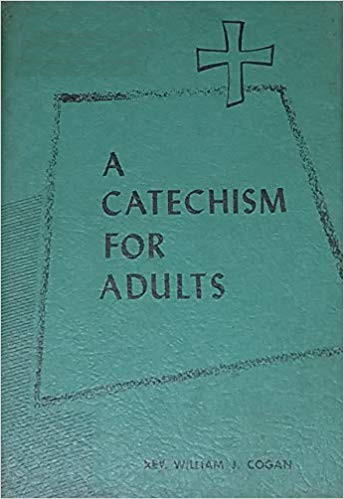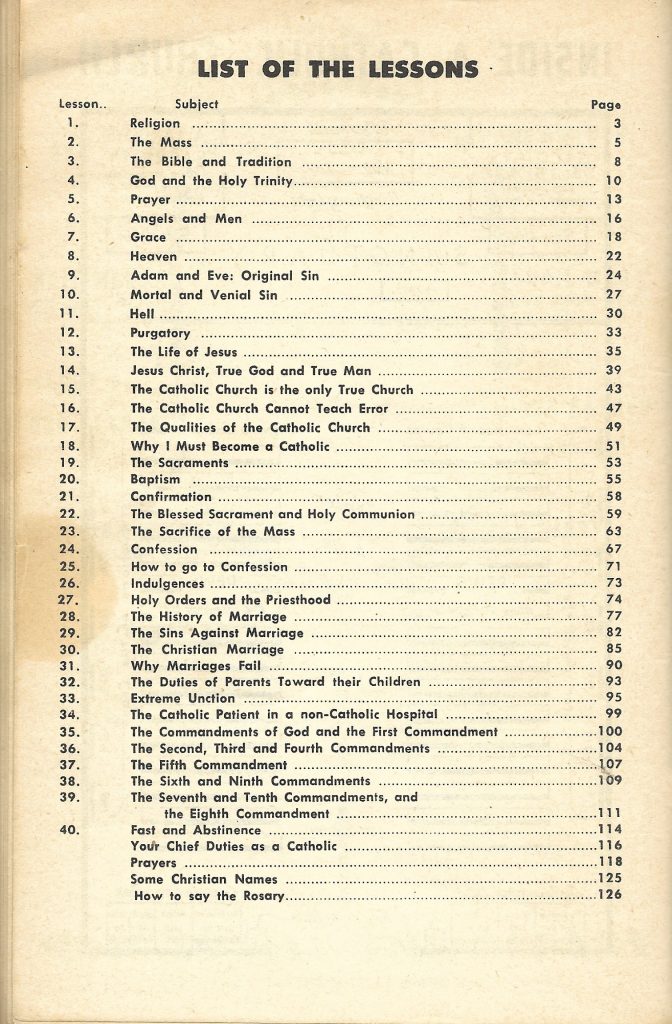Skip to Lessons
Resources & Links
A Catechism for Adults -PDF

Introduction
This site contains a course of study on traditional Catholic Teachings. It’s free to use. The topics covered remain valid in the Catholic Church even today.
I began looking into the availability of on-line courses that taught traditional Catholicism and had a difficult time finding anything. So, I registered a domain and started looking for content.
Most of the websites I have created serve me privately. I have used them as repositories and this site has much the same purpose. I have organized the materials to allow one to find information I run across while researching the subject of Catholic tradition.
A friend in upstate New York suggested a book entitled, A Brief Catechism for Adults : A Complete Handbook on How to Be a Good Catholic. I bought a copy. The latest publisher simply reprinted an earlier book entitled, A Catechism for Adults; 42 Lessons Covering 44 Subjects from Religion to the Rosary. The Glenmary Missioners used it to carry the faith to rural America. For example, Bishop Strickland attended Glenmary mission masses in a conference room at the bank in Atlanta, Texas before he went to Dallas to attend seminary.
Father William Howard Bishop founded Glenmary in 1939 to serve what he termed “No Priest Land, USA.” Father William wanted to bring the Catholic faith to poor, neglected and forgotten people who inhabited rural America. He saw what the Church had failed to see-that there were vast areas in the United States that were starving for the Bread of Life.

During the Pope Benedict XVI years, I came to realize that I had less knowledge of the faith than those rural Americans in 1939 and that’s practically none. Why?
Benedict began what many in the Catholic Church regarded as a counter-revolution. He began undoing the reforms implemented after the Second Vatican Council of the 1960’s. That included among other things, reinstituting the Traditional Latin Mass or Tridentine Mass he called the “Extraordinary Form”.
I had just started learning about the Catholic Church I joined in 2004, when the Pope issued Summorum Pontificum (English: “Of the Supreme Pontiffs”) an apostolic letter of in July 2007. It specifies among other things the circumstances in which priests of the Latin Church may celebrate Mass according to what the Pope called the “Missal promulgated by Blessed John XXIII in 1962” (the latest edition of the Roman Missal, in the form known as the Tridentine Mass or Traditional Latin Mass), and administer most of the sacraments in the form used before the liturgical reforms that followed the Second Vatican Council.
The document carried an effective date of 14 September 2007. Pope Benedict released an explanatory letter at the same time.
The document superseded the letter Quattuor Abhinc Annos of 1984 and the motu proprio Ecclesia Dei of 1988, which had allowed individual bishops, under certain conditions, to establish places where Mass could be said using the 1962 Missal.
Benedict’s letter granted greater freedom for priests to use the Tridentine liturgy in its 1962 form, stating that all priests of the Latin rite Church may freely celebrate Mass with the 1962 Missal privately. It also provided that “in parishes where a group of the faithful attached to the previous liturgical tradition stably exists, the parish priest should willingly accede to their requests to celebrate Holy Mass according to the rite of the 1962 Roman Missal” and should “ensure that the good of these members of the faithful is harmonized with the ordinary pastoral care of the parish, under the governance of the bishop”.
The Latin Liturgy of the Pontificale Romanum is allowed for the celebration of all the seven sacraments (even if the Holy Orders is not expressly mentioned). It is also allowed for the Roman Breviary to the clergymen ordered in sacris (deacons, priests, bishops).
In his accompanying letter, Pope Benedict explained that his action aimed at broadly and generously providing for the rituals which nourished the faithful for centuries and at “coming to an interior reconciliation in the heart of the Church” with Traditionalist Catholics in disagreement with the Holy See, such as the members of the Society of St. Pius X. He stated that, while it had first been thought that interest in the Tridentine Mass would disappear with the older generation that had grown up with it, some young persons too have “felt its attraction and found in it a form of encounter with the mystery of the Eucharist particularly suited to them.”
In view of fears expressed while the document was in preparation, he took pains to emphasize that his decision in no way detracts from the authority of the Second Vatican Council and that, not only for juridical reasons, but also because the requisite “degree of liturgical formation and some knowledge of the Latin language” not found very often, “the Missal published by Paul VI and then republished in two subsequent editions by John Paul II, obviously is and continues to be the normal Form – the Forma ordinaria – of the Eucharistic Liturgy.”

The website Fisheaters helped me understand what I did not know about the Traditional Latin Mass and how the church reform occurred. It does an excellent job of explaining what happened.
https://www.fisheaters.com/traditionalcatholicism.html
I wanted to use A Catechism for Adults; 42 Lessons Covering 44 Subjects from Religion to the Rosary as a guide for compiling a free on-line course that any individual, parish or diocese could use. As I began reviewing the material, I realized that it contained what the authors called “updates”. I thought of something the late Anne Roche Muggeridge wrote in her book, The Desolate City: “I wrote years ago that the new liturgy was devised by ideologues and installed by dupes. Do I still stand by this harsh judgment? Yes, I do. “
You might also consider the “updates” in the Catechism for Adults devised by ideologues and installed by dupes. In case you don’t know, radical leftists threw a revolution in the 1960’s and 70’s to remake the Church. They formed permanent national synods to police their changes. Those people still rule. Call them the occupation, because that sums up the situation.
A similar situation occurred in France in the 1700’s and led to the French Revolution. The Bishops formed synods and councils and ruled over priests and the laity and that eventually let to the collapsed of the Bishop’s councils, loss of all church property to the state, beheading of clergy and secular humanism as the official religion of France for period of years.
Where does that leave someone who wants to follow the teachings of Jesus Christ as given to the Apostles as the Deposit of Faith? Well, you have to look the true teachings up because the ideologues who instituted the changes in the way Catholics worship have no intention of informing you about what Jesus said in Mathew 28:19-20, “Going therefore, teach ye all nations: baptizing them in the name of the Father and of the Son and of the Holy Ghost. 20 Teaching them to observe all things whatsoever I have commanded you. And behold I am with you all days, even to the consummation of the world.”
The reformers of the 1960’s and their descendants seem to hover over faithful Catholics whether laity, priests, religious or bishops enforcing the reforms. While Pope Benedict XVI attempted to bring tradition back to the Church by making liturgical reforms, his term of office got interrupted by deep state actors. Supposedly, he had a health crisis. It looks like the government simply needed to halt his work and give us a confused man to head Catholic teaching.
I searched for a book similar to the one mentioned above and used by Missioners. I found the 1951 edition. Like the Traditional Latin Mass, Church teachings were never abrogated. Vatican II did not change the infallible teachings of the Church. The national synods simply implemented their enforced reality of reform.
If you do not believe you became Catechized properly, I hope the material provided here will help you. You can work through the lessons (provided by the missionaries back in the early 1950’s and possibly as far back as 1938) online or you can download the PDF file.
I admit that I did not receive proper Catechesis. My first journey into the church started with a pitiful clergy. After receiving the rites of a Catholic during Easter Vigil following RCIA, I returned and attended RCIA classes again for two years. I attended Mass every Sunday for five years. My RCIA instructors told me that I would learn the faith by attending Mass and asking questions. They suggested getting a guide.
I did all that. I went to daily Mass, met on Fridays with a deacon but I never understood the faith. During RCIA, I had an instructor explain LGBTQ+ acceptance. During a homily, one of the priests explained how other great teachers existed in the world but we needed to follow the one that showed us the light. In other words, pure ecumenism.
I’m a former investigative journalist and best selling author. I decided to put my research hat on and go after the truth. Believe it or not, some great traditional Catholics do exist and they continue to fight for the faith. I’ll introduce you to them along with providing the 1951 publication of a Catechism for Adults.
You might ask if a Lay person can do this? Well according to
The Encyclical “Sapientiae Christianae” Given by His Holiness Leo XIII:
No one, however, must entertain the notion that private individuals are prevented from taking some active part in this duty of teaching, especially those on whom God has bestowed gifts of mind with the strong wish of rendering themselves useful. These, so often as circumstances demand, may take upon themselves, not, indeed, the office of the pastor, but the task of communicating to others what they have themselves received, becoming, as it were, living echoes of their masters in the faith. Such co-operation on the part of the laity has seemed to the Fathers of the Vatican Council so opportune and fruitful of good that they thought well to invite it. “All faithful Christians, but those chiefly who are in a prominent position, or engaged in teaching, we entreat, by the compassion of Jesus Christ, and enjoin by the authority of the same God and Saviour, that they bring aid to ward off and eliminate these errors from holy Church, and contribute their zealous help in spreading abroad the light of undefiled faith.”
Let each one, therefore, bear in mind that he both can and should, so far as may be, preach the Catholic faith by the authority of his example, and by open and constant profession of the obligations it imposes. In respect, consequently, to the duties that bind us to God and the Church, it should be borne earnestly in mind that in propagating Christian truth and warding off errors the zeal of the laity should, as far as possible, be brought actively into play.

I hope you find this site helpful. Please don’t give up. Our Lord hasn’t given up on us. Keep your faith.
